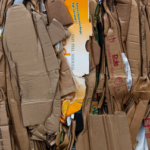
Glass or plastic: which is better for the planet?
When it comes to packaging, it’s easy to overlook the environmental impact of our choices. But did you know that the materials used in packaging, such as plastic and glass, can have a significant impact on the environment? In this post, we’ll take a closer look at plastic and glass packaging and help you decide which one is better for the environment.
Let’s start with plastic packaging. It’s cheap, lightweight, and durable, which makes it a popular choice for manufacturers. However, plastic is non-biodegradable, which means it can take hundreds of years to decompose. As a result, plastic packaging can accumulate in landfills and oceans, causing harm to wildlife and polluting the environment.
Plastic production also requires a significant amount of energy and resources. The process involves extracting non-renewable resources and using chemicals that can harm the environment. Additionally, plastic production is a significant contributor to greenhouse gas emissions.
Despite these drawbacks, plastic packaging has some environmental benefits. It’s lightweight, which reduces transportation emissions and fuel consumption. Plastic packaging also has a longer shelf life than other materials, which reduces food waste.
Now, let’s talk about glass packaging. Glass is made from natural materials, such as sand, and is fully recyclable. This means that glass packaging can be reused and repurposed, reducing the amount of waste that ends up in landfills and oceans.
Glass packaging also has a lower carbon footprint than plastic. The production of glass requires less energy and resources than plastic, and the use of natural materials means that it has a lower environmental impact.
However, glass packaging is heavier than plastic, which increases transportation emissions and fuel consumption. Glass is also fragile, which means that it can break during transportation, leading to product loss and waste.
So, which one is better for the environment? While both plastic and glass packaging have their advantages and disadvantages, glass packaging is generally considered to be more environmentally friendly than plastic. Glass is fully recyclable and has a lower carbon footprint than plastic. Additionally, glass packaging does not release harmful chemicals into the environment during production or disposal.
To make the most environmentally friendly choice, it’s important to consider the entire life cycle of the packaging material. This includes the extraction of raw materials, the manufacturing process, transportation, and disposal. By considering these factors, it’s possible to choose packaging materials that are better for the environment and help reduce pollution and harm to wildlife.
In conclusion, both plastic and glass packaging have their advantages and disadvantages. Plastic packaging is durable and lightweight but has negative environmental impacts, including pollution and harm to wildlife. Glass packaging is fully recyclable and has a lower carbon footprint than plastic but is heavy and fragile. Overall, glass packaging is a better choice for the environment due to its lower environmental impact and recyclability. By making informed choices about packaging materials, we can all help reduce pollution and harm to wildlife and create a more sustainable future.




